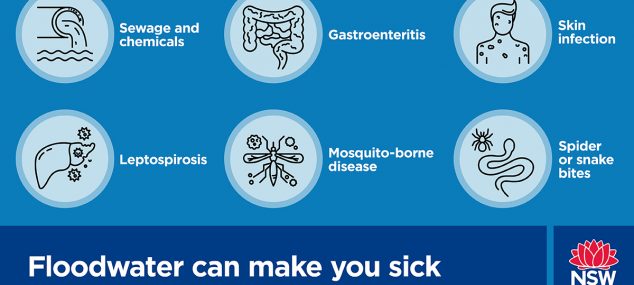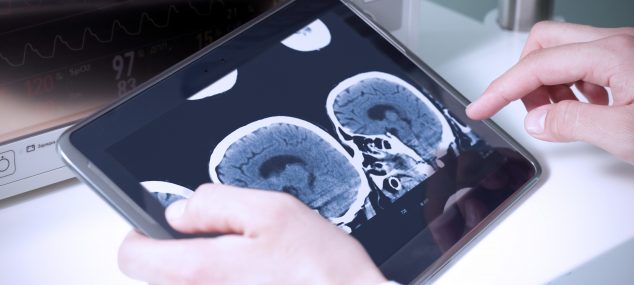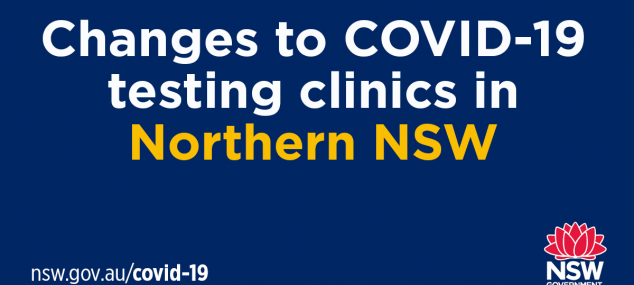Published
2021/04/09 at 8:10 am
Public Health Advice – don’t swim in floodwaters

With the ongoing rain and recent minor flooding across the region, residents are reminded to take care to avoid unnecessary contact with floodwaters and not swim in areas affected by floods or runoff.
“Floodwaters can contain many pollutants that are harmful to your health. You don’t know where the water has come from,” Director North Coast Public Health, Paul Corben, said.
“Avoid entering floodwater as it may be contaminated with raw sewage or chemicals from a backyard garden shed. These hazardous chemicals and germs can easily make you sick or lead to infection.
“Should you need to clean up please remember to wear safety equipment including boots, gloves and eye protection and wash your hands thoroughly.
“Never swim in floodwaters or near stormwater drains. Unpredictable currents and submerged hazards are very dangerous.”
People are advised to not swim in oceans for 24 hours after heavy rain. Avoid rivers, lagoons or estuaries affected by floodwaters and runoff for three days.
“Avoid swimming if you see signs of pollution such as discoloured water, oil or scum on the water, and litter or other debris floating in the water or on the tide line,” Mr Corben said.
“Swimming in contaminated water may cause illness, including ear infections, eye infections, fever and diarrhoea.”
If you rely on tank water, please be aware of the potential for contamination from polluted flood water and have your water tested and treated if necessary. If in doubt, use alternative clean water until the rainwater tank is confirmed safe to use.
Mosquitos and other disease-transmitting biting insects can also become a problem, particularly when floodwaters start to recede and leave still pools where insects quickly breed. Avoid insect bites by using insect repellent and wearing appropriate personal protection such as long sleeves, shoes and socks.
Click here for more advice on staying healthy during and after floods and storms.
If you need emergency assistance in a flood or storm, call the State Emergency Service (SES) on 132 500. For a medical, police or fire emergency call Triple Zero (000).
Published
2021/04/08 at 9:37 am
Telestroke service reaches Clarence Valley patients

Stroke patients in the Clarence Valley will now have 24-hour access to an innovative telehealth service as part of a $21.7 million initiative being rolled out across NSW.
The NSW Telestroke Service offers people living in regional and rural areas increased access to life-saving stroke diagnosis and treatment by connecting local doctors to specialist stroke physicians via video consultation.
“This crucial service will provide Clarence Valley residents with rapid diagnosis and treatment from the state’s expert clinicians,” Clarence Health Service Director of Emergency, Dr Will Davies, said.
“Telestroke helps local doctors to decide the most appropriate treatment option for each patient which may include urgent treatment at their hospital to dissolve a clot or urgent transfer to a specialised stroke centre for more complex treatment.”
The new Telestroke service at Grafton Base Hospital means patients will benefit from specialist stroke assessments closer to home, reducing the time between the onset of a stroke and a potentially life-saving intervention.
“Stroke is a time critical medical emergency that can kill up to 1.9 million brain cells per minute,” Dr Davies said.
“Every minute counts, so the faster we can provide specialist advice and interventions, the better patient outcomes will be.”
Every year, around 19,000 residents in NSW have a stroke. More than a third of people hospitalised for stroke in NSW are from regional, remote or rural areas.
The NSW Telestroke Service is managed by Sydney’s Prince of Wales Hospital and implementation of the service is a collaboration between the hospital, eHealth NSW, the Agency for Clinical Innovation and the Ministry of Health. The service has already helped more than 500 patients in NSW since its launch in March 2020 and will expand to up to 23 sites across NSW by June 2022.
The NSW Telestroke Service is a $21.7 million NSW Government election commitment announced in March 2019 and jointly funded by the NSW and Commonwealth Governments.
Footage of the NSW Telestroke Service is available at: https://vimeo.com/295104771
Published
2021/04/07 at 12:36 pm
Changes to COVID-19 testing clinics in Northern NSW

Northern NSW Local Health District is grateful for the large community turnout for COVID-19 testing over recent weeks.
“With testing numbers now trending back towards the levels seen prior to the recent case of COVID-19, we are standing down several of the additional clinics,” Wayne Jones, Chief Executive Northern NSW Local Health District, said.
From today, Wednesday 7 April, the QML Pathology drive through clinics at Lennox Head, Ballina and Lismore are now closed.
QML Pathology drive through clinics in Byron Bay and Tweed Heads will remain open today from 8am to 2pm.
The Byron Bay QML Drive Through clinic will close after Wednesday.
The Byron Bay walk-in pop up clinic which was previously located at Byron Bay High School will move back to the Byron Bay Surf Club, on Bay Street, Byron Bay on Thursday 8 April and Friday 9 April from 9am to 5pm.
All four hospital testing clinics in Tweed Heads, Lismore, Byron Bay and Grafton remain open seven days a week, with extended hours from 9am to 6.30pm.
There are multiple GP and respiratory clinics also available throughout the region.
“I wish to thank all the health staff, both from our own public health service and the private providers, who responded so quickly to allow us to deliver these extra clinics in such a quick timeframe last week,” Mr Jones said.
To find your nearest testing clinic visit
https://www.nsw.gov.au/covid-19/how-toprotect-yourself-and-others/clinics or contact your GP.